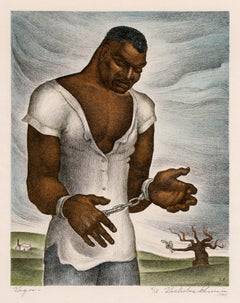Thomas Hart Benton, 'Threshing', lithograph, 1941, edition 250, Fath 48. Signed in pencil. Signed in the stone, lower left. A fine, richly-inked impression, on off-white, wove paper, with full margins (1 3/8 to 1 5/8 inches), in excellent condition. Published by Associated American Artists. Image size 9 5/16 x 13 13/16 inches (237 x 351 mm); sheet size 12 1/2 x 16 5/8 inches (318 x 422 mm). Archivally matted to museum standards, unframed.
Impressions of this work are held in the following museum collections: Art Institute of Chicago, Fine Arts Museums of San Francisco, High Museum of Art, McNay Art Museum, Montgomery Museum of Fine Arts, and Nelson-Atkins Museum of Art.
ABOUT THE ARTIST
“Benton’s idiom was essentially political and rhetorical, the painterly equivalent of the country stump speeches that were a Benton family tradition. The artist vividly recalled accompanying his father, Maecenas E. Benton — a four-term U.S. congressman, on campaigns through rural Missouri. Young Tom Benton grew up with an instinct for constituencies that led him to assess art on the basis of its audience appeal. His own art, after the experiments with abstraction, was high-spirited entertainment designed to catch and hold an audience with a political message neatly bracketed between humor and local color.” —Elizabeth Broun “Thomas Hart Benton: A Politician in Art,” Smithsonian Studies in American Art, Spring 1987, p. 61
Born in 1889 in Neosho, Missouri, Benton spent much of his childhood and adolescence in Washington, D.C., where his lawyer father, Maecenas Eason Benton, served as a Democratic member of Congress from 1897 to 1905. Hoping to groom him for a political career, Benton’s father sent him to Western Military Academy. After nearly two years at the academy, Benton convinced his mother to support him through two years at the Art Institute of Chicago, followed by two more years at the Academie Julian in Paris.
Benton returned to America in 1912 and moved to New York to pursue his artistic career. One of his first jobs was painting sets for silent movies, which were being produced in Fort Lee, New Jersey. Benton credits this experience with giving him the skills he needed to make his large-scale murals.
When World War I broke out, Benton joined the Navy. Stationed in Norfolk, Virginia, he was assigned to create drawings of the camouflaged ships arriving at Norfolk Naval Station. The renderings were used to identify vessels should they be lost in battle. Benton credited being a ‘camofleur’ as having a profound impact on his career. “When I came out of the Navy after the First World War,” he said, “I made up my mind that I wasn’t going to be just a studio painter, a pattern maker in the fashion then dominating the art world–as it still does. I began to think of returning to the painting of subjects, subjects with meanings, which people, in general, might be interested in.”
While developing his ‘regionalist’ vision, Benton also taught art, first at a city-supported school and then at The Art Students League (1926–1935). One of his students was a young Jackson Pollock, who looked upon Benton as a mentor and a father figure. In 1930, Benton was commissioned to paint a mural for the New School for Social Research. The ‘America Today’ mural, now on permanent exhibit at the Metropolitan Museum of Art, was followed by many more commissions as Benton’s work gained acclaim.
The Regionalist Movement gained popularity during the Great Depression of the 1930s. Painters, including Benton, Grant Wood, and John Steuart Curry, rejected modernist European influences preferring to depict realistic images of small-town and rural life—reassuring images of the American heartland during a period of upheaval. Time Magazine called Benton 'the most virile of U.S. painters of the U.S. Scene,' featuring his self-portrait on the cover of a 1934 issue that included a story about 'The Birth of Regionalism.'
In 1935, Benton left New York and moved back to Missouri, where he taught at the Kansas City Art Institute. Benton’s outspoken criticism of modern art, art critics, and political views alienated him from many influencers in political and art scenes. While remaining true to his beliefs, Benton continued to create murals, paintings, and prints of some of the most enduring images of American life. The dramatic and engaging qualities of Benton’s paintings and murals attracted the attention of Hollywood producers. He was hired to create illustrations and posters for films, including his famous lithographs for the film adaptation of John Steinbeck’s ‘Grapes of Wrath’ produced by Twentieth Century Fox.
Benton’s work can be found at the Art Institute of Chicago, High Museum of Art, Fine Arts Museums of San Francisco, Library of Congress, McNay Art Museum, Metropolitan Museum of Art, Minneapolis Institute of Arts, Montgomery Museum of Fine Arts, National Gallery of Art, Nelson-Atkins Museum of Art, Smithsonian American Art Museum, Whitney Museum of American Art, The Truman Library and many other museums and galleries across the US. He was elected to the National Academy of Design, has illustrated many books, authored his autobiography, and is the subject of ‘Thomas Hart Benton,’ a documentary by
Ken Burns.

